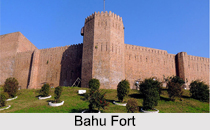 Bahu fort is mainly known as one of the historical sites in Jammu city. It also gains a lot of popularity for the ancient Kali Temple which is located inside the Bahu Fort. This temple is usually known as "Bhave Wali Mata Ka Mandir" which is dedicated to Goddess Kali who is the presiding deity of Jammu.
Bahu fort is mainly known as one of the historical sites in Jammu city. It also gains a lot of popularity for the ancient Kali Temple which is located inside the Bahu Fort. This temple is usually known as "Bhave Wali Mata Ka Mandir" which is dedicated to Goddess Kali who is the presiding deity of Jammu.
Location of Bahu Fort
Bahu fort is situated only 5 kilometres from the central part of the Jammu city, it stands tall and powerful on the left bank of the Tawi River. The Bahu fort is located at a height of 325 metres opposite the old town of Jammu.
History Bahu Fort
The fort, according to the legends was built to highlight peaceful co-existence and mutual living among all the sections of people. It is believed that Raja Bahu Lochan and his brother both were peace loving and wanted that all should live mutually. The kings once found a tiger and a goat drinking water from the same river. This gave them the idea to construct a fort in the area which shall signify the same feelings for human beings as well. This brought the legendary Bahu fort which is equally known for its architecture and topography along with its well maintained layout. All this attract a large number of tourists who visit the area for worshiping the deity while at the same time enjoys the scenic beauty of the fort. The earliest historical recorded connection to the fort is that of Raja Jambu Lochan and his brother Bahu Lochan. Bahu Lochan is ascribed with building the fort. The present fort was rebuilt, by Autar Dev, the grandson of King Kapoor Dev in 1585. They first established temples for their deities; the image of Mahakali deity in the temple located inside fort was brought from Ayodhya.
Architecture of Bahu Fort
The forest area that surrounds the Bahu fort has been developed in similar style that resembles the Mughal gardens of Kashmir. The garden of Bahu fort is enlisted as one of the most well maintained gardens of Jammu and Kashmir. The fortified structure has thick walls made up of sandstones built with lime and brick mortar. It has eight octagonal towers which are connected with the thick wall. Besides the usual structures which are commonly found in all the forts, there is a sacred tank which shall allow the pilgrims to take bath in this tank.
The fort has a broad gateway which is fit for the entry of the elephants. The fort also includes an underground imprisonment which is one of the most attractive parts of the fort. With these exclusive structures the fort has turned to be one of the most exciting tourist spots of Jammu city. The temple of Goddess Kali is made up of white marble which is equally attractive in structure. It is a renowned Shakti temple built within the fort during the 8th century. It is a small temple which can put up only a few worshippers at a time at the Mandapa, outside the chamber sanctorum.
Festivals of Bahu Fort
A popular Hindu festival known as "Bahu Mela" is held in the "Navaratras" in the fort area, twice a year. This attracts a very large number of pilgrims to the fort. Tuesday and Sunday are special days of worship at the temple. During the main festival time, special stalls are opened near the fort area selling sweets, flowers, coconuts and red cloth to make special offerings to the deity in the temple.
Bahu fort stands as another important historical structure which attracts a large number of tourists from all corners of India. Its kali temple is considered to be one of the most sacred shrines of Jammu along with other well known shrines of Jammu and Kashmir.






